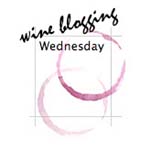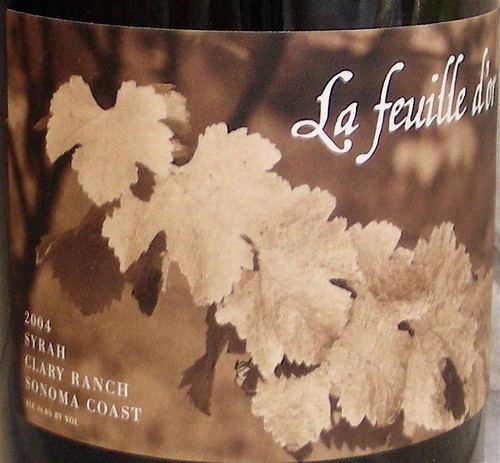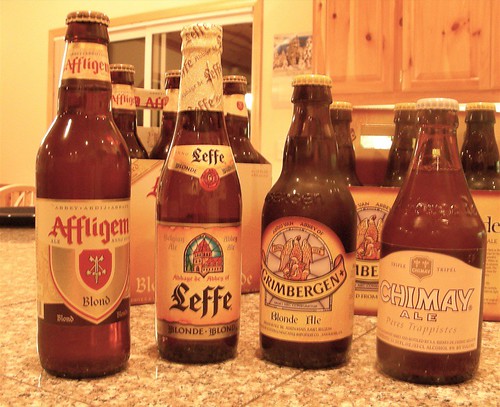A trendy tapas restaurant in Old Pasadena, a tasty offering of small plates, a well designed wine list with a good selection of Spanish wines by the glass: this looked like the best recipe for a great evening. Unfortunately, two out of the four wines that we ordered by the glass were plainly undrinkable.
We started with a Viña Nora Albarino and a Faustino V Rioja Blanco. We liked the Albarino a lot. It was floral, fresh, zesty. But we were pretty disappointed by the Rioja, which tasted flat, tired, and had very little flavors. We told our waitress about the wine but decided to move on and try some red wines instead: a Campo Viejo Rioja Reserva and a Borsao Campo de Borja, which is a Garnacha/Tempranillo blend from the region of Aragón. The Rioja had bright fruity and spicy flavors, perfect with our Spanish meatballs in a mushroom sauce. The Borsao, on the other hand, had an unpleasant port-like pruny taste.
This was a real surprise to me to find so many oxidized wines that evening. How could such a fairly upscale restaurant not properly avoid wine spoilage in its uncorked bottles?
Complaining a second time, we finally got a free Priorat Garnacha. And this one was fine.
Technorati tags: wine food & drink
The smell of wine, oh how much more delicate, cheerful, gratifying, celestial and delicious it is than that of oil. François Rabelais (1495-1553)
Tuesday, February 27, 2007
Sunday, February 18, 2007
My best airline wine so far: a Riesling from Lufthansa
It is during a recent trip to Frankfurt that I discovered Lufthansa's excellent wine offering. First of all, alcoholic drinks are free in economy class. They are served by the glass from large 1 Liter bottles, one white, one red. On my flight, the white wine was a German Riesling and the red looked like a Cabernet Sauvignon. I decided to taste the Riesling.
I have to admit that I was pleasantly surprised by the wine. It had a fine floral nose. The palate was light, refreshing, slightly fizzy, rather dry, with I guess, a low alcohol content, great qualities to fight the dryness of the cabin air and enhance the blandness of the airline food — which was honestly not so bad.
While I was sipping my Riesling, I watched the movie A good Year. I was curious to see whether the movie's reputation was true. True indeed: no real soul, not even funny. The Riesling was much more satisfying.
Technorati tags: wine food & drink
I have to admit that I was pleasantly surprised by the wine. It had a fine floral nose. The palate was light, refreshing, slightly fizzy, rather dry, with I guess, a low alcohol content, great qualities to fight the dryness of the cabin air and enhance the blandness of the airline food — which was honestly not so bad.
While I was sipping my Riesling, I watched the movie A good Year. I was curious to see whether the movie's reputation was true. True indeed: no real soul, not even funny. The Riesling was much more satisfying.
Technorati tags: wine food & drink
Friday, February 09, 2007
Wednesday, February 07, 2007
WBW #30: my own new world Syrah
 Tim at WineCast is our host for this 30th edition of Wine Blogging Wednesday and the theme that he has chosen this month is New World Syrah. The rule is simple: the wine needs to be made from at least 51% Syrah or Shiraz and come from the New World.
Tim at WineCast is our host for this 30th edition of Wine Blogging Wednesday and the theme that he has chosen this month is New World Syrah. The rule is simple: the wine needs to be made from at least 51% Syrah or Shiraz and come from the New World.The wine that I have selected today is a Syrah from California. However, you will not be able to find it anywhere — except in the cellar or wine cabinet of a few people — because it is a wine that we made ourselves, with the effective assistance of the Crushpad winemaking team. We designed it, punched it, pressed it, barreled it, and finally bottled it just a year ago. Only 25 cases were made.
So after one year in bottle, is the wine any good? You bet!
Our goal was to make a Syrah in the Northern Rhône Valley style, spicy and complex, but not too big. Therefore, we got our fruit from the cool climate Clary Ranch Vineyard, located in the Sonoma Coast AVA, just eleven miles from Tomales Bay. The fruit was destemmed but not crushed, leaving mostly whole berries for fermentation, then aged for 15 months in a one year old Burgundy barrel.
 The 2004 La Feuille d'Or Syrah Clary Ranch Vineyard is a blend of Syrah with a dash of Viognier to add floral notes to the blend. After one year in bottle, it has a deep garnet color and an attractively aromatic nose of red berry and vanilla. The palate is medium-bodied, juicy, and fruity, leaving a long peppery finish. This is a very food friendly wine that should be enjoyed now or within a few years.
The 2004 La Feuille d'Or Syrah Clary Ranch Vineyard is a blend of Syrah with a dash of Viognier to add floral notes to the blend. After one year in bottle, it has a deep garnet color and an attractively aromatic nose of red berry and vanilla. The palate is medium-bodied, juicy, and fruity, leaving a long peppery finish. This is a very food friendly wine that should be enjoyed now or within a few years.Thanks Tim, this was a great theme!
Related stories:
• Making our own wine!
• Making our own wine: update 2
• Making our own wine: update 3
• Making our own wine: update 4 (bottling)
Technorati tags:: wine food & drinkwine blogging wednesday wbw wbw30
Tuesday, February 06, 2007
And another excellent biodynamic wine: the 2005 Pic Saint Loup Clos Marie l'Olivette
 I almost chose the 2005 Pic Saint Loup Clos Marie l'Olivette for our last Wine Blogging Wednesday but I couldn't taste it in time for the event. So we finally tried it this weekend.
I almost chose the 2005 Pic Saint Loup Clos Marie l'Olivette for our last Wine Blogging Wednesday but I couldn't taste it in time for the event. So we finally tried it this weekend.The Clos Marie L'Olivette belongs to a relatively new appellation, the Coteaux du Languedoc Pic Saint loup, a region located some 30 kilometers north of Montpellier. It is dominated by the Pic Saint Loup itself, a pointed mountain rising 638 meters above the sea level. The soil is poor and stony, mostly clay and limestone. The region has a more northerly climate than the rest of the Coteaux du Languedoc with cooler average temperatures and slightly higher rainfall. It has also stricter appellation rules. Noble grape varieties such as Grenache, Syrah, and Mourvèdre must account for at least 90% of a blend.
Clos Marie is a 20 hectare domain located near the village of Lauret, one of the thirteen villages included in the Pic Saint Loup appellation. It is run by Christophe Peyrus who took over the family's vineyards in 1991. Before that, the wine was sold to the local co-operative. He made drastic changes in order to improve the quality of the wine, unrooting and replanting 75% of the vineyard with a high planting density, and adopting manual harvesting. He also started farming the vineyard using biodynamic principles in 2000.
The cuvée L'Olivette is the domain's basic offering. It is a blend of 40% Grenache, 40% Syrah, and 20% Mourvèdre, aged in 1/3 new oak, 2/3 neutral barrels. The wine has a dense purple color and a sweet nose of blackberry. The mouthfeel is full and unctuous, leaving a fine dusty aftertaste. Simply delicious, addictive, and highly recommended!
Technorati tags: wine food & drink
Thursday, February 01, 2007
Another choucroute and beer tasting
My friend Virginie doesn't like wine but enjoys beer a lot and she really loved the choucroute and beer tasting that we did last year. So the other weekend, we did it again. We were at the ski cabin and it was unusually cold outside: 18°F! We had spent half the day skiing cross country to keep us warm and now we were hungry! Our Choucroute (sauerkraut) was slowly cooking in the oven; it was time to get the beers out of the fridge.

This year, we selected some Abbey beers from Belgium including a Trappist. Trappist beers are made by abbey monks from the Trappist order. Monastery brewhouses used to exist all over Europe because the monks were brewing beer to earn their living. But today, only seven Trappist breweries continue to produce beer, six in Belgium and one in the Netherlands. Unlike Trappist beers, Abbey beers are not made by monks anymore. Instead, they are produced by commercial breweries under license from the Abbeys.
We started with the Affligem Blonde. Affligem Abbey is a Benedictine monastery in Flemish Belgium. Until 1970, brewing was the responsibility of the abbey's monks. Today, the making of the beer has been taken over by the nearby Affligem brewery, under license from the monks. The Affligem Blonde is a classic Abbey Ale, with a clear and deep yellow color and a toasty, nutty, and slightly bitter taste.
The Grimbergen Blonde Ale was created by monks of the Norbertine order from the Grimbergen abbey. Like all the abbey beers, the Grimbergen is a high fermentation beer, which means that the fermentation takes place at a temperature varying between 15°C and 25° whereas low fermentation temperatures are around 8°C. The beer had a pleasant nose of citrus and honey. The palate had a definite sweetness and not much bitterness.
The Chimay Blanche or Triple is a Trappist beer brewed by the monks of the Notre-Dame de Scourmont abbey in the town of Chimay. Like with all the Trappist breweries, the monks are making beer to financially support the abbey. The beer is non-pasteurized. After being bottled, it is allowed to ferment a second time for three weeks before being shipped. The Chimay beers can age well, at least five years and up to fifteen years for the Chimay Bleue, a dark and strong ale. The Chimay Blanche had a darker color and a compact foam. The color was slightly hazy. On the palate, it was dry and hoppy with a long bitter finish.
The Leffe Blonde comes originally from the abbey Notre Dame de Leffe, but today, all Leffe brands are brewed at the Stella Artois brewery in Leuven. The beer had a glowing golden color and a flavorful and refreshing palate, followed by a long finish.
My friend Virginie fell in love with the honeyed sweetness of the Grimbergen. Personally, I thought that the Affligem was particularly well balanced and a great accompaniment to the sour cabbage and the spicy sausages of the choucroute.

Technorati tags: wine food & drink

This year, we selected some Abbey beers from Belgium including a Trappist. Trappist beers are made by abbey monks from the Trappist order. Monastery brewhouses used to exist all over Europe because the monks were brewing beer to earn their living. But today, only seven Trappist breweries continue to produce beer, six in Belgium and one in the Netherlands. Unlike Trappist beers, Abbey beers are not made by monks anymore. Instead, they are produced by commercial breweries under license from the Abbeys.
We started with the Affligem Blonde. Affligem Abbey is a Benedictine monastery in Flemish Belgium. Until 1970, brewing was the responsibility of the abbey's monks. Today, the making of the beer has been taken over by the nearby Affligem brewery, under license from the monks. The Affligem Blonde is a classic Abbey Ale, with a clear and deep yellow color and a toasty, nutty, and slightly bitter taste.
The Grimbergen Blonde Ale was created by monks of the Norbertine order from the Grimbergen abbey. Like all the abbey beers, the Grimbergen is a high fermentation beer, which means that the fermentation takes place at a temperature varying between 15°C and 25° whereas low fermentation temperatures are around 8°C. The beer had a pleasant nose of citrus and honey. The palate had a definite sweetness and not much bitterness.
The Chimay Blanche or Triple is a Trappist beer brewed by the monks of the Notre-Dame de Scourmont abbey in the town of Chimay. Like with all the Trappist breweries, the monks are making beer to financially support the abbey. The beer is non-pasteurized. After being bottled, it is allowed to ferment a second time for three weeks before being shipped. The Chimay beers can age well, at least five years and up to fifteen years for the Chimay Bleue, a dark and strong ale. The Chimay Blanche had a darker color and a compact foam. The color was slightly hazy. On the palate, it was dry and hoppy with a long bitter finish.
The Leffe Blonde comes originally from the abbey Notre Dame de Leffe, but today, all Leffe brands are brewed at the Stella Artois brewery in Leuven. The beer had a glowing golden color and a flavorful and refreshing palate, followed by a long finish.
My friend Virginie fell in love with the honeyed sweetness of the Grimbergen. Personally, I thought that the Affligem was particularly well balanced and a great accompaniment to the sour cabbage and the spicy sausages of the choucroute.

Technorati tags: wine food & drink
Subscribe to:
Comments (Atom)